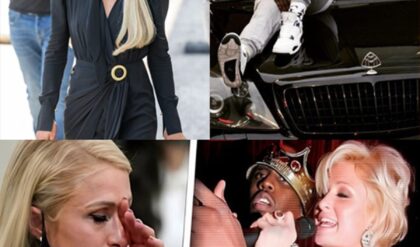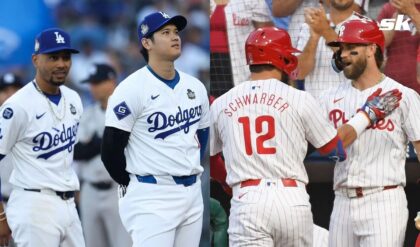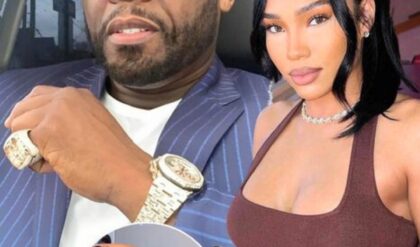Highlights Include New Setlist Additions, A Playful Duet With Wife Patti Scialfa, And Powerful Moments Addressing Current Issues. A Must-See For Fans, It’s A Moving Journey Through The Boss’s Legacy
It goes without saying that a lot has happened since “Springsteen on Broadway” finished its first run on December 15, 2018. And although most theaters remained closed on this sultry summer Saturday evening two and a half years later, the Boss has seen fit to lead Broadway’s reopening, as if to give a cautiously optimistic signal to audiences — hey, if Bruce thinks it’s okay, it should be okay. However, as we bustled toward the St. James Theatre for opening night of his autobiographically-themed show’s second run, it was clear that the people in the packed-to-almost-pre-pandemic-level Times Square (maybe a third of whom were masked) had already gotten the memo.
Announced less than three weeks ago, this summer-long second run came as a surprise: After 14 months, 236 performances, a $113 million-plus gross, an album and a Netflix film, the “Broadway” book seemed closed. But like that change-of-heart master Neil Young, Springsteen obeys an inner voice only he can hear — one that tells him to abandon completed albums; to announce that he and his band are going on a long tour just weeks after he’s told them they’re not; and to cut half the songs from “The River” in the middle of the tour celebrating that album’s 35th anniversary (replacing them with songs from his first two albums, naturally). The official explanation is that a friend suggested reviving the Broadway show, the man thought it “would be fun,” and here we are. But the bigger picture is that it’s a careful first step to major live performances before taking on the exponentially larger risks of an arena or stadium tour, which bandmembers (all of whom are in their 60s or 70s) have said is likely in 2022. Plus, the fact that “Springsteen on Broadway” Part II coincides precisely with public school summer vacation makes for a subtle, suitably Springsteenian theme.
After passing a handful of anti-vaxxers protesting the show’s vaccine requirement — one of whose sign read “Bruce Springsteen is for segregation on Broadway,” whatever that means — we presented our digital ticket, proof of vaccination and photo I.D., and entered a theater buzzing with a level of anticipation high even for the Boomer-aged Boss faithful. Minutes before the lights dimmed, E Street Band guitarist Little Steven Van Zandt walked toward his fourth-row seat to a roar and standing ovation from the crowd, seemingly half of which then bounded forward to get a photo of the poor guy before he’d even sat down. (We’ll bet that’s one thing he hasn’t missed.) New Jersey Governor Phil Murphy (whose attendance was probably mandated by state law) and former presidential candidate Pete Buttigieg were also in the house but did not receive a similar welcome.
The Moment — that moment of Springsteen first walking onstage, after 15 months of a horrifying pandemic — would have seemed perfect for a dramatic, heartwarming, defining statement of resilience and hope about faith and unity and the the endurance of the human spirit. But instead, Springsteen quieted the whooping crowd with a jovial “Shut the fuck up, please!,” and started the show very similarly to the previous run’s beginning: “If you wanna be a big rock star, the first thing you’ve gotta do is have an image that you sell to the peoples,” following with him being raised in a part of the country built on Boardwalk fraud and he is no exception, and how his career and a show are a big magic trick — all leading into the opener, “Growin’ Up.”
However, he did address the moment before the next song, “My Hometown.” “It’s been a long time coming!,” he shouted, noting how nice was to see people “unmasked, sitting next to each other in the same room,” and caught up the audience on how he spent his pandemic: releasing an album with the E Street Band, recording a radio show and a podcast with President Obama, and, oh yeah, “I was handcuffed and thrown in jail!,” he laughed, referencing his arrest just miles from his home last November, when he accepted two shots of tequila from fans, hopped on his motorcycle and was immediately pulled over by police.
He waited through the crowd’s laughter, then continued, “I had to go to Zoom court — my case was the United States of America versus Bruce Springsteen. That’s always comforting to hear — that the entire nation is aligned against you. ‘You have managed to engage in an act so heinous that it has offended the entire fucking United States! You, my recalcitrant, lawbreaking bridge and tunnel friend, have drunk two shots of tequila!’ My hometown,” he sighed. “New Jersey, they love me there.”
The bulk of the show is largely similar to the first run — which Variety reviewed during its October 2017 previews, again five months later and spoke with him about — yet there were some striking differences. He yelled and casually cursed a bit more, and certain reminisces — which are based on his “Born to Run” autobiography — have been cut, abridged, rushed or extended, as would anyone who’s telling the same story for the 237th time. He also changed up his delivery on several songs in a singalong-defying way: “Growin’ Up” had jittery strumming; “Born in the U.S.A.” is even more of a gospel-blues holler, played with a slide on 12-string guitar; he sang “Thunder Road” in his Woody Guthrie-esque semi-Southern accent.
But most strikingly, he softly choked up with emotion several times, and seemingly not because it was his first concert since the pandemic began: It came as he remembered people from his past, from high school friends who died in Vietnam to longtime saxophonist and wingman Clarence Clemons (“I’ll see you in the next life, Big Man”); from his late father to his mother, now 95 and a decade into Alzheimer’s. He spoke of how much she loved to dance, and when he visits her these days and puts on the 1940s Glenn Miller music that she loves, she moves in her seat and reaches out for him to dance with her.
Each song in the set is identified with people from his life. He spoke, wistfully and at length, about his father (“My Father’s House”) and mother (“The Wish”), the bandmates he left his hometown with at 19 (“Thunder Road”), his high school friends who’d died in Vietnam as well as “Born on the Fourth of July” author Ron Kovic (“Born in the U.S.A.”), the E Street Band and Clemons (“Tenth Avenue Freeze-Out”), and of course his backing singer and wife of 30 years, Patti Scialfa, who joined him for their trademark duet, “Tougher Than the Rest.” Springsteen nearly forgot the final verse and she laughed at him — “See? She loves me even when I fuck up.”
It was followed by the first of three songs new to the set. Instead of the usual “Brilliant Disguise,” they did a playful duet on “Fire,” the Springsteen song that was a 1979 No.2 hit for the Pointer Sisters, and it ended up being the highlight of the night. They traded off on the first verse but sang the second and third together — beautifully — sharing the microphone. Patti drew laughs by holding a long note, raising her finger to his lips to shush him so she could sing it herself.
Scialfa left the stage and the show got more serious, as Springsteen spoke briefly about these “troubled times,” although with less foreboding than he did during the Trump-era first run. “In 71 years on the planet, I haven’t seen anything like this past year: The Bill of Rights and the Constitution have been so bludgeoned and disrespected that I’m frightened for us,” he said. “But I still cling, maybe naively, to that beautiful quote by Dr. [Martin Luther] King that says, ‘The arc of the moral universe is long, but it bends toward justice.’” He waited out the applause before continuing, “Now, he neglected to mention that it does an awful lot of zigging and zagging along with way,” to laughter. “And oh my God, have we zagged, but I’m still stubborn, and I’ve lived long enough to see that that arc doesn’t bend on its own. To reach its goal, it takes all of us leaning on it and pushing it in the right direction.”
He followed with another new addition, a tacit nod to the Black Lives Matter movement: “American Skin,” which was written in the wake of Amadou Diallo’s 1999 death at the hands of New York police. Obviously, it’s tragically more relevant today; he repeated the line “You can get killed just for living” four times. He then went directly into the more hopeful “The Rising,” which was written after 9/11 but is also just as timely.
As Springsteen wound the show down with a story about the big, majestic tree that had stood in front of his childhood home — and how, just before he finished his autobiography, he discovered it had been cut down — his misting grew into genuine tears.
“We live amongst ghosts trying to reach us from that other life,” he said. “And they’re still with us. I’m glad to be doing this show again, to get to visit with my dad every night, and Clarence, and Danny [Federici, longtime E Street Band member], and my Randolph Street family — all gone. A whole way of life disappears before your very eyes, but the soul remains.
“I just want to let them know that I remember them,” he said before tearing up so much that he wiped his eyes with both hands — “Aw, fuck” — before laughing, “You know what they say about Catholics.”
With that, he was back on track, closing as usual with the Lord’s Prayer, before finishing the night with “I’ll See You in My Dreams,” from his most recent album, “Letter to You” — which was the biggest change in the setlist, since he’d previously closed with an exuberant “Born to Run.”
Whether that omission was an opening-night aberration or a decision to change the vibe of the finale remains to be seen — but there’s a hot sun beating on the blacktop, and you’ve got all summer to find out.








